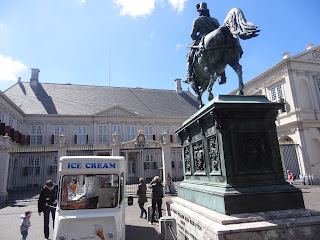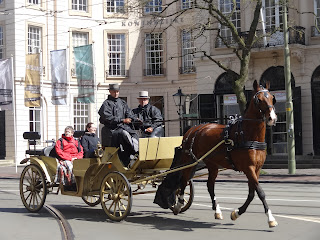First thing we did when we got off the train was head for the tourist information building. There we bought a map of Den Haag and a "Walking the the Hague" booklet....which is a self guided walking tour of Den Haag.
We started the tour with #30 on the list in the booklet, De Bijekorf. Built: 1923-1926. It has a wavy alternating brickwork and glass strips on the facade.
Of the original interior, only the stairwell made of costly wood and stained glass remains.
Next stop (across the street): Peek & Cloppenburg, built in 1932.
We saw this cute building on the route.....not listed in the pamphlet...
#32 in the pamphlet: De Volharding built in 1927. This striking building is a highlight of architecture in the Netherlands between 1850 and 1940.
#33 Lutheran Church build in 1754 in classical style, on the roof you see swans, which are a symbol of the religious denomination of the church.
We then walked on to the Grote Markt. The 14th century Elizabeth Convenant stood here. Remnants of the convent were discovered during construction of the tram tunnel.
(I just thought this was a beautiful building...mixing old and new architecture!):
Then we entered the "Haagsche Bluf", which is a cute shopping area:
As we exited the Haagsche Bluf we saw:
We decided to stop for lunch at the 't Goude Hooft Inn (#35 in the pamphlet). Since the Middle Ages, the 't Goude Hooft Inn has been situated on this spot. The inn was replaced in 1938.
Our view from the terrace:
We walked around the corner to #38-Passage, which was built between 1882 and 1885. In one of the halls above the entrance the first retrospective exhibition of works by Vincent Van Gogh was held in 1892, two years after his death.
Next stop was Old Town Hall, which was built in the 16th century on the cellars of the medieval Hof van Brederode where the village hall was founded around 1450.
Then on to #41, The Grote or St. Jacob's Church. This church, originally Catholic, stems from the 14th century. After a fire in 1539, the church was completely restored. The last restorations was in 1987, when the church was adapted for multifunctional use.
Next on the list was the Kantoorgebouw Berlage, built in 1895. This building, unfortunately, was covered with scaffolding!
#44 in the pamphlet is the Old Men's Home. The former Old Men's Home was founded in 1772.
Another interesting building:
We continued on our walk......thought this was cute!
#46 was next.....the Walloon Church, build in 1808. Simple neo-classical church was built with a donation from Louis Napoleon and is primarily known for its impressive organ (we did not go inside)...
On to #47 in the pamphlet....Noordeide. This is to the left of the Noordeinde Palace and is the former private dwelling of Prince Royal Willem-Alexander. He lived there from 1995 till his marriage with Princess Maxima. The house dates from 1757 and is built on the foundations of an old dwelling from the 16th century. The house can be reached through the inside from Noordeinde Palace.
Our walk continued next door to the Noordeinde Palace. It was formerly called "The Old Court". It originated through the alteration and extension of a 16th century house. In 1609 the States presented it as a gift to Frederik Hendrik and his mother. The large alteration of 1640 was ordered by Frederik Hendrik. In 1813, after the inauguration of Willem I as king of the Netherlands, a start was made for further alterations and extensions. The equestrian statue of Prince William of Orange in front of the gate dates from 1845.
#49-Council of State built in 1716. This was formerly Kneuterdijk Palace.
#51-St. Jacobus Church, build 1875-1878. The tower of this neo-Gothic church is over 90 meters. The interior with its wealth of altars, sculptures and stained glass windows is one of the best preserved from that period in the Netherlands.
#54-Pages' House built in 1618. The Pageshuis has one of The Hague's few remaining 17th century stepped gables. Since 1867 the house has been used by the Red Cross.
On to "Embassy Row".....
The British Embassy:
The Swedish Embassy:
#58-Supreme Court of the Netherlands, built in 1734.
We decided to go inside for some coffee and a little something sweet! The interior is so pretty! There was a pianist playing in the corner of the room......so relaxing!
After leaving there we walked by #60, The Escher at the Palace, build between 1760-1764. This building was built as a residence of Anthony Patras, delegate of Friesland to the States General. Napoleon spent a night here in 1811 when he visited his brother Louis Napoleon, King of Holland. In 1845, the building came into the possession of the Royal House. Currently the former palace is a permanent museum for the works of artist M.C. Escher.
We walked next to #61, The Embassy of the United States of America, which is on the corner of Lange Voorhout and Korte Voorhout. During the bombardment of 3 March, 1945, all the buildings on Korte Voorhout (with the exception of the Royal Theatre), were destroyed. This embassy was built at the end of the 1950's. It was the only embassy that looked like a fortress......kind of sad.....
Next was #62, the Royal Theatre, built from 1766-1774. The front section of the Royal Theatre with the curved facade is merely a part of a large palace that was never completed. In 1804, the building was made into a theatre.
We walked around the corner...On the left is the Maritshuis Royal Cabinet of Paintings with the adjacent "Torentje", which houses the Dutch Prime Minister's Office. The Maritshuis was, unfortunately, closed for renovations.
We continued to #66, The Cabinet of the King, build in 1633.
Opposite this house, an ashlar compass rose with an arrow pointing north is visible in the pavement. It probably dates from the 17th century:
We then passed the Stadhouderspoort and entered the Binnenhof:
#4-On the Binnenhof stands the former castle of the EArls of Holland, build in the 13th and 14th century.
After leaving the Binnenhof we went on to #13-The Ministry of Defense, built from 1739-1746.
We walked over to the Plein. In the center of the of the Plein stands the bronze statue of stadholder Prince Willem I, made in 1848. We stopped and had a beer while watching it pour down rain from our table under the awning!
After finishing our beer, we headed back to the train station......A few sites along the way:
On the way home.....more fields of flowers!




































































































